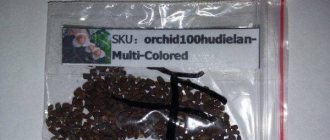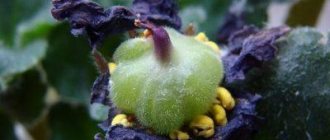What is culture
The orchid is gaining more and more fans every day, and there is no point in explaining what orchids look like. Despite the difficulties of growing a flower, many people purchase sprouts and seedlings. But not everyone can afford to buy an adult plant.
The history of the appearance of this flower is ancient. The very first mentions of orchids were found approximately 130 million years ago. Previously, this plant was classified as a medicinal crop.
Growing an orchid at home has become possible thanks to the effective work of botanists. They have developed varieties that can grow and reproduce at home. The orchid is a very capricious home crop; you can get abundant, beautiful blooms by fully observing all the requirements and conditions for growing.
An orchid is an indoor crop that reproduces by seeds, shoots, and bulbs. The most difficult method is growing from seeds.
Features of care
Orchid care procedures bring a lot of trouble to a novice gardener. But professionals say that it is easy to get beautiful flowering at home if you follow all the conditions and rules.
It is very important to provide proper lighting, which is of great importance for the flower. It is necessary to provide bright light, but it must be diffused.
On a note! The flower will not die under direct rays. But the bright light will cause the leaves to lighten and stretch, but the flowers may not appear. Thin tulle or lutrasil is enough to diffuse the rays.
Temperature changes are beneficial for orchids to bloom abundantly. Temperatures can range from 18 to 27 degrees.
During the active growth period, abundant watering is important, and in winter the moisture supply should be reduced. Drought is not as bad for an orchid as excess water. It is best to water according to the shower principle, or pour it into a plate and place the pot in it for 15 minutes.
During the dormant period (from autumn to spring), the flower can not be shaded, since there will be few rays. There will be enough of them for new shoots to form and buds to form. During this period, the temperature is reduced to 13-18 degrees.
Compliance with sterilization rules
The germination time of orchid seeds is much longer than this process for harmful microorganisms. Therefore, in the absence of sterilization, instead of plant sprouts on a nutrient medium, you can get mold, which will suffocate the germinating seeds .
Instruments should be sterilized before use.
All components of the process must be sterilized : utensils, tools, nutrient medium and the seeds themselves:
- To disinfect glass containers in which seeds will germinate, you can use an oven : keep the flasks in the oven for about an hour and let cool. Boil lids with holes for air exchange, dry and plug the holes with sterile cotton wool;
- The nutrient medium is sterilized during the preparation process and poured hot into prepared vessels. The solution should be poured using a funnel so that drops do not fall on the walls and a source of infection does not form;
- The containers with the solution are tightly closed with lids , boiled in a water bath for 20 minutes and cooled on a horizontal surface. After a day, boiling is repeated;
- The flasks, ready for sowing, are kept for 5 days at room temperature to determine the correctness of sterilization. If no mold has appeared, the environment is ready for use. The sealed containers are stored in the refrigerator for several months;
- The seeds are disinfected immediately before sowing by keeping them for a quarter of an hour in a bleach solution (15 g per 100 ml of water) with constant shaking.
Orchid seeds, what are they?
Orchid (phalaenopsis) seeds ripen in a box with 3 or 6 leaves. There are up to 4 million of them, the length of one reaches from 0.3 to 3.3 mm. You can only use mature seed after the boll has dried. Orchid seeds look like dust or sand due to the large number and small quantity. The dust from the seeds is not black, but yellowish-cream in color.
Collecting seeds is very difficult. But nature compensated for the size of the achenes with a large number of them in the box. Under natural conditions, orchids reproduce by seeds. The wind carries the seed dust, the seeds fall on the bark and leaves of the trees and germinate.
It takes about 2.5-3 months for the seed to fully ripen.
Caring for seedlings
The time for seed germination depends on the specific species of orchid and can take about 10 days or, like in humans, 9 months. The seeds swell, over the course of one and a half months they acquire a green color (chlorophyll is formed) and produce suction hairs.
In order for the seeds to germinate, they need proper care.
After another 2 months, the seed balls enlarge, taking on the shape of a disk, and the first leaf sprouts - a protocorm is formed . Soon the next two leaves appear, and then the real roots.
Planting of sprouted seeds is possible approximately one year after sowing:
- Warm water is poured into the flask;
- Shake gently;
- And pour the contents into a wide bowl;
- A solution of foundationazole (2-3 ml) is also added there for disinfection.
After a quarter of an hour, the seedlings are transferred with a brush or tweezers with soft edges to a steamed orchid substrate, but smaller and with activated carbon. The container should be glass to control the development and disease of the roots.
Seedling care consists of:
- Placing them in a greenhouse;
- And regular spraying of the soil with warm water.
ADVICE! It is impossible to water the transplanted seedlings due to the possible development of rot, but it is also unacceptable to overdry the substrate.
Young plants are provided with lighting and humidity of more than 60% . The temperature regime is left the same as during germination.
Collecting seeds
Collecting seeds is difficult, but doable. As the box grows, a napkin is tied to it in the form of a pocket so that dust does not fly away when the walls begin to crack. A mature capsule turns brown (in rare cases it remains green).
When the boll is dry, cut it off and transfer the seed dust onto a piece of paper. Planting such small seeds is very difficult. This is another reason why seed propagation often fails.
Breeding orchids by seeds
Orchid seeds are not able to germinate under normal conditions, like other plants. Since they do not provide special nutrient reservoirs (endosperm) that nourish the embryo in the first stages of growth.
On a note!
Germination requires a special nutrient medium for orchid seeds. Under natural conditions, the culture grows in symbiosis with fungi.
What you need
To grow orchids from seeds, you will need to ensure you have:
- glass containers with a volume of 300-400 ml (flasks or jars with lids) where the seeds are sown;
- a small glass jar for the sterilization procedure;
- rubber or cotton wool plugs;
- disposable syringes;
- litmus strips;
- 2% hydrogen peroxide solution.
The lids are also prepared before use. They are placed in a thin glass tube, the top hole of which is closed with a cotton ball. A second similar hole is also made and covered with an adhesive plaster (seeding is performed through it).
Preparing tools
All materials, instruments and containers are sterilized before use. This will help protect young shoots from damage by pathogenic bacteria.
If at the very beginning of the experiment you violate the basic rules of sterility, then you may not continue the experiment. The seeds will no longer be viable.
Soil preparation
To germinate orchid seeds, you can use a ready-made nutrient medium or make it yourself. You can grow an orchid at home from seeds with large flowers only in a special composition. It will not be possible to sow seeds in ordinary soil; they will die immediately.
Ready mix options
To grow an orchid from seeds at home, you can buy Knudson’s ready-made nutrient medium. It is dissolved according to the instructions. Orchids from seeds should be grown in this composition due to their special composition:
- agar-agar (a polysaccharide that helps the composition achieve jelly density);
- sugar;
- the salts included in the composition are in a balanced amount.
After preparation, use a litmus strip to check the acidity of the resulting medium.
On a note!
It is necessary to check acidity only at room temperature, since in warm compositions the acidity is lower.
After preparation, the nutrient mixture is heated and poured into jars (no more than 60 ml of the jelly-like composition is placed in 200 ml).
Making your own mixture
You can make a nutrient medium for germinating orchid seeds on your own, following simple step-by-step instructions.
- 10 g of fructose glucose and 8 g of agar-agar are added to half a liter of boiling distilled water.
- Mix the options over low heat until the agar-agar dissolves.
- In the second container, another 0.5 liters of water are heated and 1.5 g of fertilizer (nitrogen, phosphorus, potassium), 5 drops of phytostimulant for root formation, 1 g. activated carbon.
- After all components have dissolved, both solutions are combined and stirred.
- If necessary, you need to reduce the acidity to 4.8-5.2 pH. The indicator is reduced by introducing a solution of potash, and increased by orthophosphorus liquid.
- 30 ml of prepared liquid is poured into each sterilized seed container.
- The flasks with the special medium are closed and sterilized for about half an hour.
- The nutrient medium and containers are left for 4-5 days. If mold forms, you will have to re-prepare the growing composition.
You can use folk recipes to make a nutrient medium.
- 450 ml potato juice, 40 g powdered sugar, 7 g special fertilizer, 20 g agar-agar, 1 tsp. lemon juice.
- 200 g of starch (from potatoes), 500 ml of coconut water, 20 agar-agar, 1-2 ml of orchid fertilizer, freshly squeezed puree from 0.5 kg of tomato.
- 460 ml distilled water, 1 tab. activated carbon, 5 g sugar, 40 ml pineapple juice, 5 g honey, 100 g starch, 2-3 special fertilizers.
To prepare a properly favorable substrate, you need to be very careful; compliance with sterility requirements is the main and important condition.
Seed treatment and direct sowing
Before planting orchid seeds, you need to sterilize them. First, the seed box is wiped with a cotton swab dipped in alcohol. Then the seed dust is poured into a small glass jar and closed with a lid. Using a syringe, a little 2% hydrogen peroxide solution is injected into the container with the seeds.
The seeds are in the container for about 5-10 minutes. The liquid containing the seeds is removed using another syringe. Pour through a hole sealed with an adhesive plaster into a jar. The liquid is carefully distributed over the surface of the nutrient medium.
On a note!
All sowing procedures are performed directly over a saucepan where water is boiling.
If you do not adhere to sterile conditions when germinating seeds, colonies of microorganisms will form on top within a week. These containers are subject to rejection.
Conditions of detention
After transferring the seeds to the nutrient medium, the jars are provided with the necessary conditions. It is important to monitor the temperature and lighting.
The sown seeds will require a temperature in the range of 20-23 degrees to germinate. 12 hours of lighting is important. At the same time, they provide diffused light.
Features of caring for sprouts
The duration of emergence of seedlings varies for different varieties. The first shoots can appear in 4-6 weeks, and sometimes wait up to 6-9 months. First, a small ball with threads of shoots is formed. They cling to the surface and consume the necessary components for further development. The first leaves will appear next, and only then the real roots will begin to form.
As long as the crops are kept under sterile conditions, no special care is required. It is important not to open the jars while they are in glass containers, violating the sterility.
Nutrient Substrate Recipes
Media containing substances necessary for seeds consist of a base substance and a composition with elements:
- Basic solution:
- Water – necessarily distilled (1 l);
- And 10 g of each of the following components : Agar-agar;
- Fructose;
- And sucrose.
- Additional composition suitable for orchids sympodial type:
- Ammonium and magnesium sulfates (250 mg each);
- Calcium nitrate (1 g);
- And ferrous sulfate (20 g).
- Additional composition used for orchids monopodial type:
- Ammonium (700 mg) and magnesium (300 mg) sulfates;
- Potassium citrates (350 mg) and iron (200 mg);
- Potassium phosphate (400 mg) and calcium nitrate (1 g).
Sometimes various products are added :
- Bananas;
- Tomatoes;
- Starch;
- Coconut water;
- Honey;
- Activated carbon to create more nutrition.
When and how to replant sprouts
It takes up to a year from sowing the seeds to the moment they are transferred to the substrate. The following composition is prepared for transplantation:
- 1 part each of crushed coniferous bark, sphagnum moss, fern rhizomes;
- 10 tab. activated carbon (pre-crushed).
A layer of classic drainage is placed at the bottom of the plastic cups, then the prepared soil is placed. The seedlings are removed from the original container in a circular motion, and the roots are washed. Carefully transfer the sprouts into cups with substrate. At first, small orchids are not watered, but simply sprayed, making sure that the soil remains moist.
The orchid is left untouched for six months, and then it is replanted in the usual traditional soil for orchids.
Sowing
Take a sterilized glass antibiotic jar with a rubber lid. Pour the seeds out of a napkin and fill 2/3 with 15% hydrogen peroxide. Leave there for 10 minutes, shaking occasionally .
Using a sterile syringe with a large needle diameter, draw 1 ml through the cap . solution _ Take out the prepared container and introduce peroxide with seeds through the lid.
Wrap the lid with cling film to prevent fungi and bacteria from penetrating inside. Gently tilting, distribute peroxide with seeds over the surface of the nutrient medium.
Place containers with sown seeds at a temperature of +21-24 degrees. After 10-14 days, the seeds swell, after about 1.5 months they begin to turn green, developing chlorophyll. Now the flasks can be given a little light, 2000-4000 lux will be enough for them. The temperature remains unchanged.
The embryos gradually increase in size, acquiring the shape of a ball with a diameter of 2 mm. After 2-3 months, the ball flattens a little, turning into a disk called protocorm, and the first leaf appears from it. The seedlings are given more light, but avoid direct sunlight. The tiny orchid will show itself in full glory in six months, and after a year the seedlings are ready to be transplanted into bowls.
Caring for young orchid sprouts
After transplantation, young orchids are closely monitored, providing the necessary care. Watering is carried out by spraying the useful substrate.
On a note!
Overmoistening should not be allowed, as the small roots are very thin and vulnerable. They can instantly rot, which will lead to the death of the young plant.
In six months, the sprouts will become stronger, they will begin to be transplanted into classic soil for adult specimens and will begin to be cared for in the traditional way. Flowers will appear after transplantation in 4-5 years.
Transplantation to a permanent place
Six months after planting the seedlings in the greenhouse, the plants will be strong enough to transplant them to a permanent place. The procedure is carried out in the same way as when planting orchids by children.
You will not need a very large pot, since exotic beauties bloom more profusely . Drainage and a specific substrate are placed at the bottom:
- Crushed pine bark;
- Moss particles;
- And pieces of peat.
Orchid roots are placed on the substrate and sprinkled on top. Transplanted children are placed in the shade and regularly sprayed . After some time, the plant is transferred to the windowsill.
Problems you may encounter
You can encounter difficulties when growing phalaenopsis from seeds at home at any stage of this procedure.
There are many reasons for poor germination:
- poor quality seed material:
- non-compliance with humidity and lighting conditions;
- flaws in creating sterility and so on.
As a result of any mistake, seeds or seedlings can be destroyed, or a plant can grow but not bloom.
Seed material
This is the first problem you may encounter. When collecting it yourself, it is difficult to guess when the seed box is at full maturity.
Buying ready-made germinating seed material is even more difficult. They purchase it by ordering on Chinese websites. But when the parcels arrive, apart from the bag of seeds, there are no instructions, collection date, variety name, and so on. There is a high probability that instead of the treasured orchid, you received the seeds of a simple lawn.
On a note!
Planting an orchid with seeds from China is like playing the lottery: you don’t know the end result. It all depends on the seller’s honesty and integrity.
Maintaining sterility
Its violation can be judged by the appearance of mold in containers. You can save germinating seeds by trying to change the substrate.
- A new jelly is prepared from the nutrient medium.
- Fill the flask with warm water and shake it slightly.
- What is contained is poured into a small container. Any 1% fungicide solution (1-2 drops) is added to the mass.
- After 15 minutes, the sprouts are placed in the prepared substrate.
Next, the container is closed again, ensuring sterility for the sprouts.
You may be interested in:
Orchid in hydrogel: planting, growing and care Orchid is a decorative flower that appeared on windowsills not so long ago. Among the various species, the most…Read more…
Main difficulties
- Microscopic size of seeds that do not have endosperm , that is, deprived of a supply of nutrients - a special environment with everything necessary is required;
- Lack of pollinating insects in the apartment - manual pollination is necessary ;
- Maintain sterility - the nutrient medium, dishes and seeds should be sterilized . Failure to comply with this point leads to the formation of mold instead of sprouts;
- Duration of seed germination – up to 9 months ;
- The wait for flowering lasts for 2-4 years , sometimes much longer (for Paphiopedilum - 10 years).











